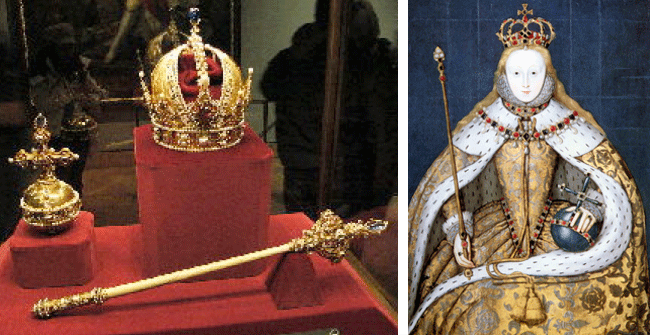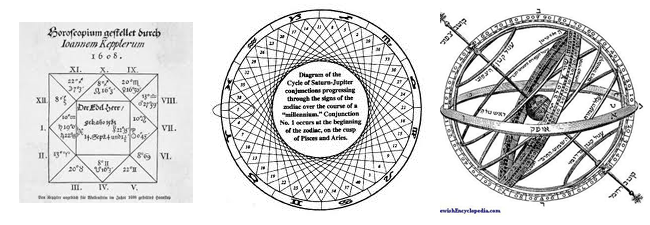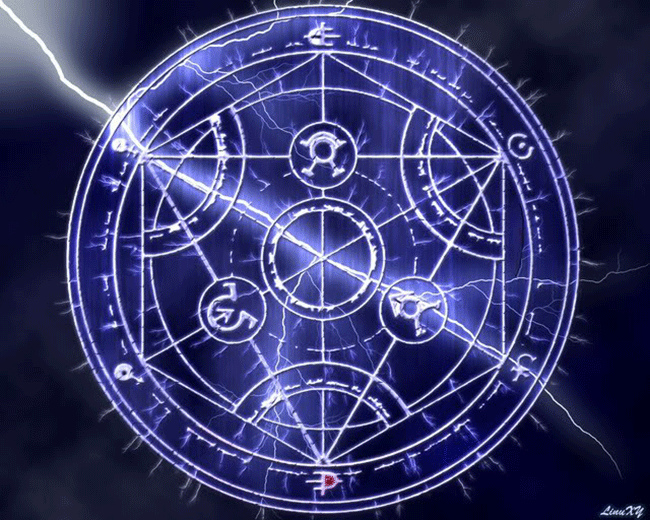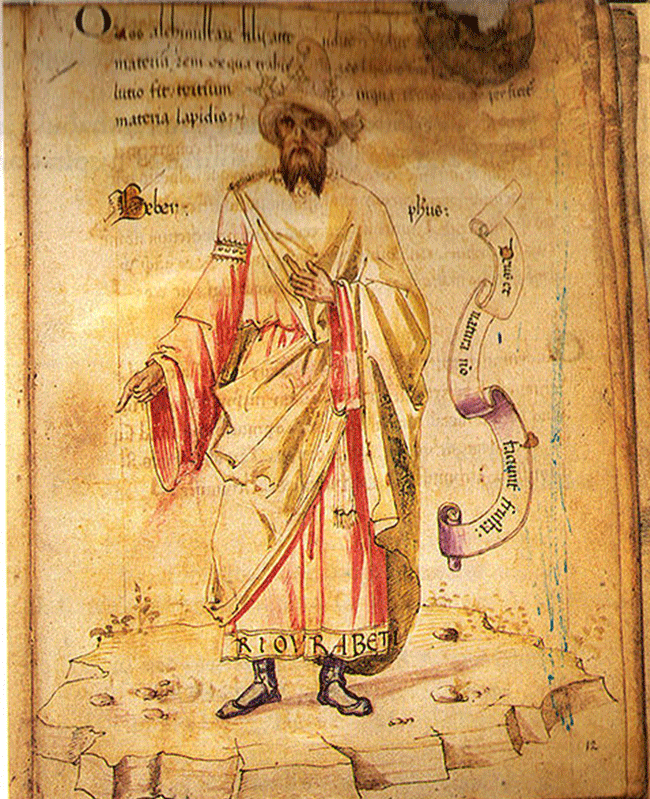The History of Alchemy
The Medieval collection is a reflection and revival of the symbolism surrounding the magnificent golden orbs atop royal scepters and crowns. The orb, which often represented the universe, was topped with a cross during the rise of Christianity. In countless medieval portraits, royalty were depicted holding a royal scepter in one hand and a golden orb in the other. In slightly more ominous portraits, the ruler was depicted with one foot resting on top of the orb to represent the extreme ruling power of the kingdom. While there are endless possibilities of the orb’s exact origins, it has retained its aura of mysterious power and divine protection throughout the tests of time.

The History of the Sacred Orb
While the orbs are most recognized in the medieval era, the origins of the first sacred orbs are thought to be ancient pagan and Celtic rituals, in which orbs were thought to represent the sun and the moon. These two glowing spheres reined over the day and night, and were worshipped as divine entities. Shamans would chant while in the presence of small spheres made of stone or crystal, in hopes that the orbs would empower their prayers.
According to esoteric mysticism, the sacred orbs may represent celestial beings and the guardian spirits of departed souls. The sphere is also considered to be a symbol of the cosmos, or the universe as a whole. In ancient Rome, the plain orb symbolized the universe represented by the god Jupiter. Roman emperors were often depicted holding a globe in hand. During battle in 312BC, emperor Constantine I had a vision of a cross above the sun, with an inscription, “In this sign, shall you conquer.” He ordered his soldiers to draw crosses on their shields, and the battle was won. Constantine defeated all his enemies in this fashion and established himself as a mighty ruler over the vast Roman Empire.
The magnificent golden orbs began appearing on crowns and royal jewelry. Kings demanded to be portrayed with the globus cruciger, believing it would give them divine powers. The image of a ruler holding a scepter and orb began appearing on coins, and soon became an iconic image of royalty in the Western world. Throughout the centuries and despite various interpretations, sacred orbs have retained their aura of mystery and power of divine protection.
Alchemy
Alchemy is an ancient philosophical tradition with its origins in the Asian and Arabic world. Regardless of its initial origin, the study of alchemy and alchemical processes has been practiced in various forms by ancient Egyptians, Greeks, Romans, Christian Europeans, Indians, Taoist Chinese and Arabic mystics.

A mystical philosophy of thought, alchemy is the ancestral science that gave birth to medicine, chemistry, astrology, and psychology. The alchemist quest was to discover an ‘Elixir of Life’ for eternal youth and longevity, and the ‘Philosopher’s Stone’ to turn base metals into noble metals such as gold and silver.

Alchemists learned how to extract metals from ores and how to compose many types of solvents and acids. Unfortunately, Mercury was one of the main elements used in their chemical experiments, and many alchemists died from frequent exposure. It was believed that if the secret of purifying gold was discovered, it could be adapted to purify the human soul and achieve immortality. Alchemy was an art, both experimental and abstract, that fused cosmic physics and sacred psychology, unifying spirit and matter.

Alchemy was also associated to astrology and dealt fundamentally with the basic mysteries of life and its transcendental mysticism. The practice was neither abstract nor theoretical, it was experimental.
The origins of Western alchemy are traced back to Hellenistic city of Alexandria in Egypt. Early alchemist practitioners and writers were Zosimos of Panopolis (c. 300 AD) and the Mary the Jewess.

More is known about Islamic alchemy because it was better documented: indeed, most of the earlier writings that have survived through the years were preserved as Arabic translations. In the late 8th century, Jābir ibn Hayyān introduced a new approach to alchemy, based on scientific methodology and controlled experimentation in the laboratory, that contrasted the ancient Greek and Egyptian alchemists whose work was overly allegorical and mystical.
Alchemy spread through Europe in the 12th century. Alchemists were experimenters, philosophers and considered the first explorers of consciousness in medieval times. Among the more famous were Paracelsus, Albertus Magnus, and Sir Isaac Newton. These eminent alchemists set the foundation for the science as we know it today.
Albertus Magnus for example, a Dominican friar, wrote over fifty books ranging from philosophy, physics, psychology, astronomy, zoology and geography.
Another well known alchemist was Paracelsus, a Swiss physician and philosopher born in 1493. Despite being repudiated and often persecuted by his peers and the authorities for his revolutionary beliefs about medicine and religion, he devoted his life to the study of alchemy. He wrote about many subjects that included chemistry, medicine, antisepsis, wound surgery, hypnosis and homeopathy. Unfortunately most of his books were banned from printing during his life time until almost hundred years later, when the scholars discovered and started to understand the importance of his work again. Sadly, he presumably died of chronic mercury exposure due his alchemical experiments.
Sir Isaac Newton (1642-1727) was a mathematical genius, as well as one of the greatest scientists who ever lived. Among others, he discovered differential calculus, and formulated the theory of gravity. He was very careful not to publish anything that was not firmly supported by his experiments or geometrical demonstrations. However, after examining the remains of Newton’s own personal notes and diaries, it was discovered that Newton was actually an alchemist. A man of great intellect and strong intuition, he tried to develop the transmutation of metals, the philosopher’s stone, and the elixir of life. Unfortunately, after his death most of his arcane manuscripts were burnt by his family in an attempt to hide these facts and avoid religious persecution.
His students and followers chose to emphasize exclusively his mechanistic view of the universe, excluding completely his spiritual and alchemical studies that he so passionately researched and worked on. Since Newton’s time, all discoveries suggesting the presence of spiritual forces that transcended time or space were ironically considered to be a violation of Newton’s Laws — even though Newton himself held these very beliefs!
The alchemic contributions of these illustrious alchemist not only improved the lives of their contemporaries, but influenced the thought of many later philosophers such as Thomas a Kempis, John Dee, Johannes Kepler, Bishop Berkeley, Emanuel Swedenborg, William Blake, Goethe and even Jung.
Carl Gustav Jung was the father of modern psychiatry and psychoanalysis. He spent a lot of time studying the subject of alchemy after an unusually vivid dream of being in an ancient library, full of arcane books. Jung insisted that the psyche cannot be understood in simple medical terms, but only through an intense analysis of dreams, images or symbols. He was amazed to find that the images and operations he encountered in the old alchemy scriptures were related to his theories of psychoanalysis and the unconscious.
Throughout history alchemy has been accused of being an obscure magic or pure nonsense, as it has never produced the ultimate Elixir of Life or the famous Philosopher’s Stone. It is undeniable however that the ancient philosophy of alchemy opened many questions about our mysterious universe and our own existence that we are still trying to comprehend today.
‘The most beautiful thing we can experience is the mysterious. It is the source of all true art and all science.’ -Albert Einstein





